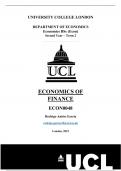Summary
ECON0048 (Economics of Finance) Summary - UCL Economics BSc Second Year
- Course
- Institution
- Book
Summary of Economics of Finance taught in ECON0048 (Year 2021/2022) Detailed notes from lecture notes, textbooks and other materials. Topics covered include: 1) Basic Concepts in Finance, Arbitrage and the Money Market, 2) Measuring Return, Arbitrage in Theory and in Practice, 3) The Bond and...
[Show more]




